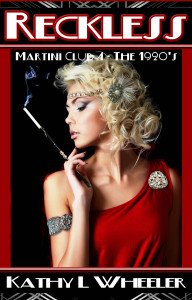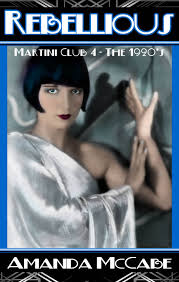It’s so wonderful to be back at the Riskies again! It feels like this is the Winter That Will Not End (illness, snow, rinse, repeat), but I am finally seeing the sunlight at the end of the tunnel. And one of the best things about spring (maybe0 being on the way, is the release of a very special project!
As a Risky reader will know, I range among many different time periods in my writing–Regency, Elizabethan, Renaissance, etc. One of my very favorite time periods (especially with the Downton mania of the last few years!) is the Edwardian/WWI/1920s era. It’s very reminiscent of the Regency in many ways (warfare, fast-moving societal changes, not to mention amazing clothes…), but I’ve only been able to write one 1920s story in the past (Girl With the Beaded Mask), but all that changed a few months ago.
 I have 3 great writer friends I get to see (almost) every Friday night, at 4:30 happy hour on the dot, at the Martini Lounge a few miles from my house. This is an amazing place, said to have been a speakeasy in the 1920s (though when I was a kid, it was my grandfather’s favorite donut shop, where I could eat as many chocolate pastries as I wanted while he talked to his old-man friends about farming!). Now it’s an elegant bar/steakhouse, with velvet booths, dim lighting, jazz music, and an astonishing array of cocktails. Kathy L Wheeler, Alicia Dean, Krysta Scott, and I meet to talk over what we’re writing, and one eveing we had the brilliant idea–why didn’t we write something together! Set at the Martini Lounge! So 4 girls from the 1920s had their beginnings in 4 connected novellas that have now been launched out into the world. Much like our 4 heroines left their English homes for new lives in NYC….
I have 3 great writer friends I get to see (almost) every Friday night, at 4:30 happy hour on the dot, at the Martini Lounge a few miles from my house. This is an amazing place, said to have been a speakeasy in the 1920s (though when I was a kid, it was my grandfather’s favorite donut shop, where I could eat as many chocolate pastries as I wanted while he talked to his old-man friends about farming!). Now it’s an elegant bar/steakhouse, with velvet booths, dim lighting, jazz music, and an astonishing array of cocktails. Kathy L Wheeler, Alicia Dean, Krysta Scott, and I meet to talk over what we’re writing, and one eveing we had the brilliant idea–why didn’t we write something together! Set at the Martini Lounge! So 4 girls from the 1920s had their beginnings in 4 connected novellas that have now been launched out into the world. Much like our 4 heroines left their English homes for new lives in NYC….
I wondered what those 4 heroines–Lady Jessica (an earl’s daughter who would rather be a journalist than dance at deb balls), Lady Meggie (her schoolfriend, who would rather sing in a jazz band and seek fame and fortune than dance at deb balls), Eliza (a maidservant who fled a lecherous employer–only to find herself in an even worse jam on the streets of NY), and Charlotte (Jess and Meggie’s shy friend, who finds the strength to flee an arranged marriage and follow her own dreams), would drink when they meet at the Martini Lounge’s 1920s counterpart Club 501?
 Alicia Dean says Eliza’s drink choice is easy–a Fallen Angel!
Alicia Dean says Eliza’s drink choice is easy–a Fallen Angel!
Shake all ingredients (except cherry) with ice and strain into a cocktail glass. Top with the cherry and serve.
 Kathy L Wheeler chose Meggie’s–a Virgin Mary (since Meggie is a singer, she doesn’t drink much on the job–but that doesn’t count for after hours!)
Kathy L Wheeler chose Meggie’s–a Virgin Mary (since Meggie is a singer, she doesn’t drink much on the job–but that doesn’t count for after hours!)
4 oz tomato juice, 1 dash lemon juice, 1/2 tsp Worcestershire sauce, 2 drops tabasco
Fill a large wine glass with ice. Add tomato juice, then the rest of the ingredients. Stir and garnish with a wedge of lime.
 I found out that one of my favorite (modern day) drinks, a French 75, was also very popular in the 1920s!!! (even with one of the models for Lady Jessica, Nancy Mitford), so I decided Jess could drink that…
I found out that one of my favorite (modern day) drinks, a French 75, was also very popular in the 1920s!!! (even with one of the models for Lady Jessica, Nancy Mitford), so I decided Jess could drink that…
1 oz. gin
½ oz. simple syrup
½ oz. fresh squeezed lemon juice
Brut Champagne or a dry sparkling white wine
Lemon twist, to garnish
Combine gin, simple syrup, and lemon juice in a cocktail shaker filled with ice. Shake until well chilled and strain into a glass. Top with Champagne and garnish with a lemon twist to serve.
 And for Charli, who has dreams of opening her own bakery, a caramel apple martini!
And for Charli, who has dreams of opening her own bakery, a caramel apple martini!
2 parts Schnapps, butterscotch, 2 parts Sour Apple Pucker, 1 part vodka. Shake ingredients in a cocktail shaker with ice. Strain into a chilled cocktail glass
We are so excited to have these stories out in the world!!! To one commenter today, we’ll give copies of the stories (either e-book or, in a few weeks, hard copies), plus a Martini Club 4 cocktail glass for mixing up your own favorite cocktails. Do you have a favorite drink? Any special happy-hour rituals with friends??
(to buy the ML stories, here is the link on Amazon, or you can visit my website for more info…)
(and if you’d like a glimpse of the real Club 501, here is their website!)









